Art Deco Treasure Chest: Daily News Building
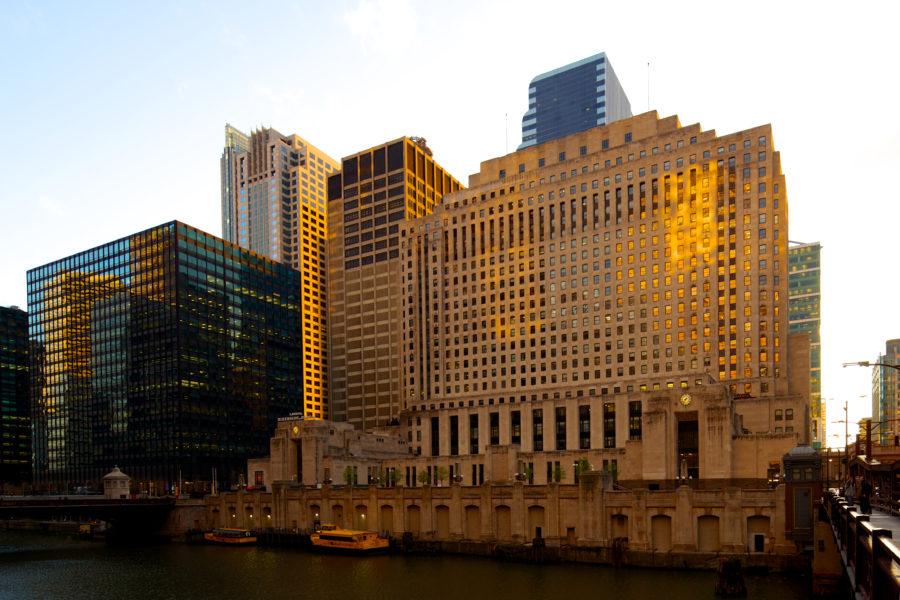
John Morris/Chicago Patterns
Between Washington and Madison Streets on the river is the Chicago Daily News building, a grand edifice constructed in 1929 at the height of Chicago’s boom era.
Much like the company that commissioned it, the building has oscillated between grandeur and peril a few times in its 85 years of existence.
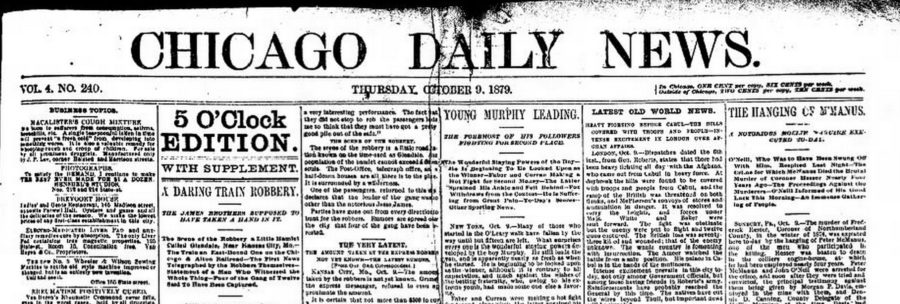
1879 afternoon edition of the Daily News
The Daily News was founded in 1875 and began its life as a penny afternoon edition paper. In the late 1880s, the cost of the morning edition was lowered to the same price, and daily circulation reached 200,000. This resulted in becoming one of the most widely read newspapers in the world.
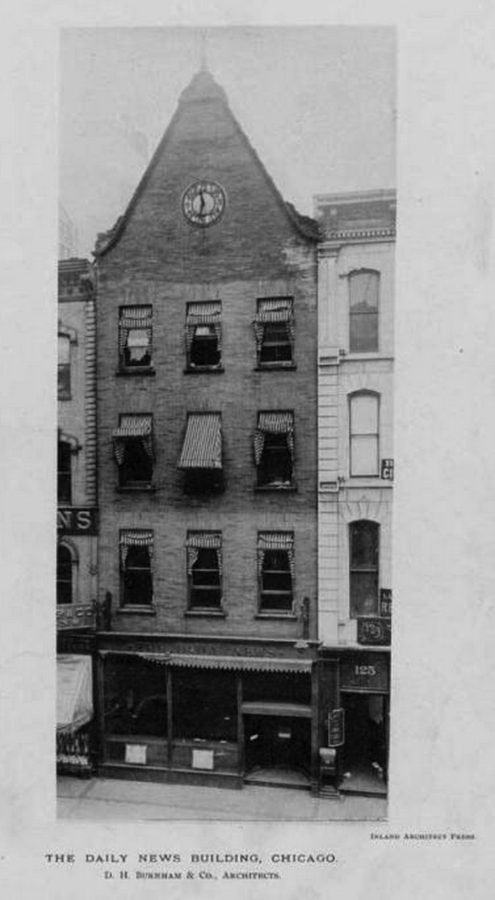
ca. 1896 photo of previous Daily News building, no longer extant. Courtesy of The Art Institute of Chicago
By the 1920s, circulation nearly doubled to 430,000, and the company began to explore options for a new building.
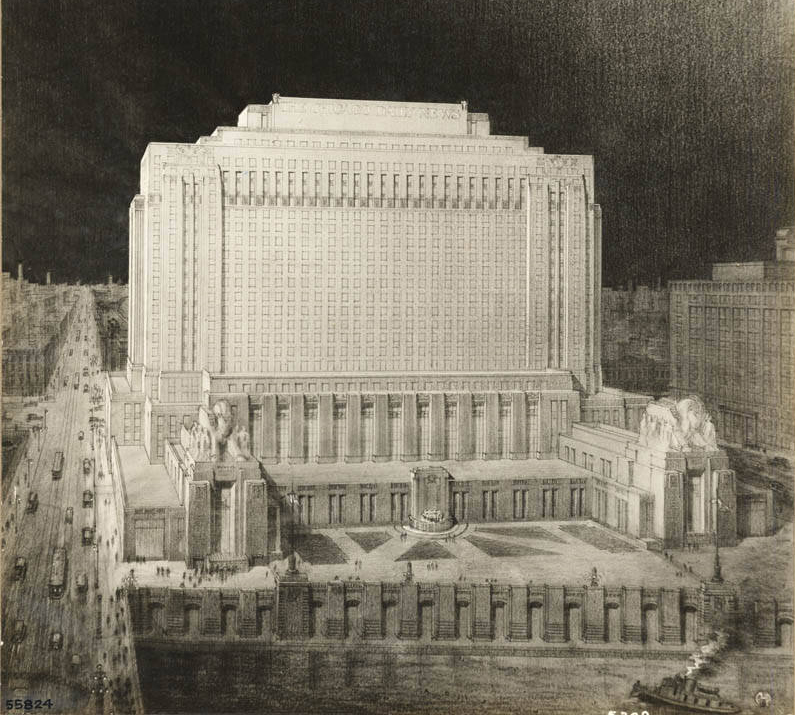
Drawing of Daily News Building, courtesy of The Art Institute of Chicago
The New Era of Art Deco
The building was designed by Chicago-based architecture firm Holabird & Root. Formerly known as Holabird & Roche, the firm rebranded after the deaths of its principle architects. The son of the firm’s founder and another local architect took over operations in 1927.
This transition marked a move away from the Chicago School of architecture which, propelled the firm to prominence, and into the new era of “functional architecture,” later known as Art Deco.
The Gothic-styled Tribune Tower was constructed a few years earlier, and executives of the Daily News viewed their new building as a representation of their rivalry. The Chicago Tribune unseated the Daily News as the city’s number one paper a few years earlier.
Precursor to Modernism
While the Tribune Tower was a grand celebration of tradition, the Daily News Building was a bold look toward the future. One common contemporary descriptor of Art Deco was “functional” — a way of conveying that the building’s appearance is defined by its purpose.
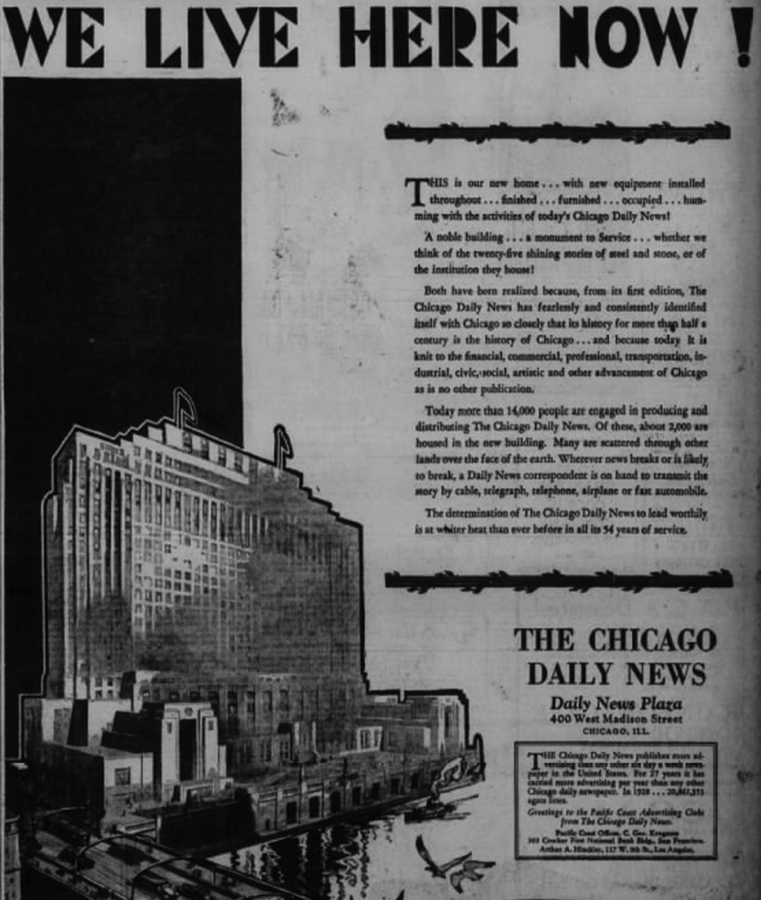
Advertisement from June 1929 Oakland Tribune
Prime Location
Access to the river and railroad was an advantage for distribution, but also for circulation and sales. This was touted by the publisher in an advertisement in another paper:
Its site is focal. Two-thirds of Chicago business people enter the Loop from the North, the Northwest, the West and Southwest Sides. Sixty-five thousand suburbanites pass through the Chicago Daily News concourse twice daily. Its space is eagerly demanded. Like the great journal is houses, it is a monument to service rendered and a pledge of greater service to come.
–Walter A. Strong, Publisher
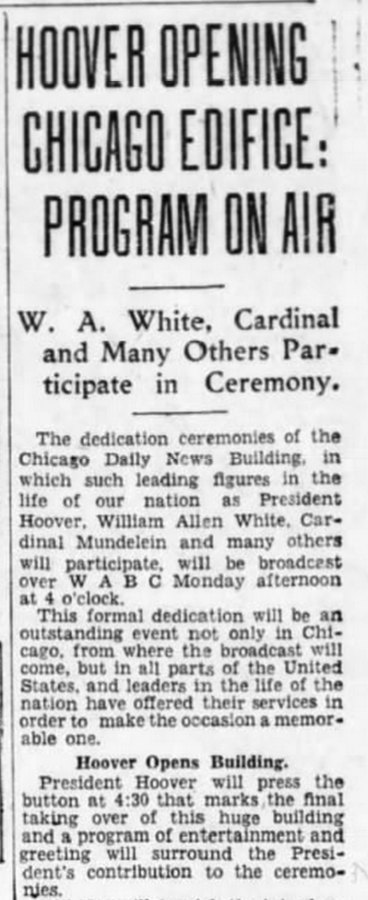
July 1929 Brooklyn Daily Eagle
Opening Celebrations with the President
The opening celebrations of the Daily News Building featured several prominent figures of American history, including the United States President:
President Hoover will press the button at 4:30 that marks the final taking over of this huge building and a program of entertainment and greeting will surround the President’s contribution to the ceremonies.
Exuberance during the most prosperous and prolific decade in Chicago history would come to a halt just a few months later, with the Stock Market Crash of 1929.
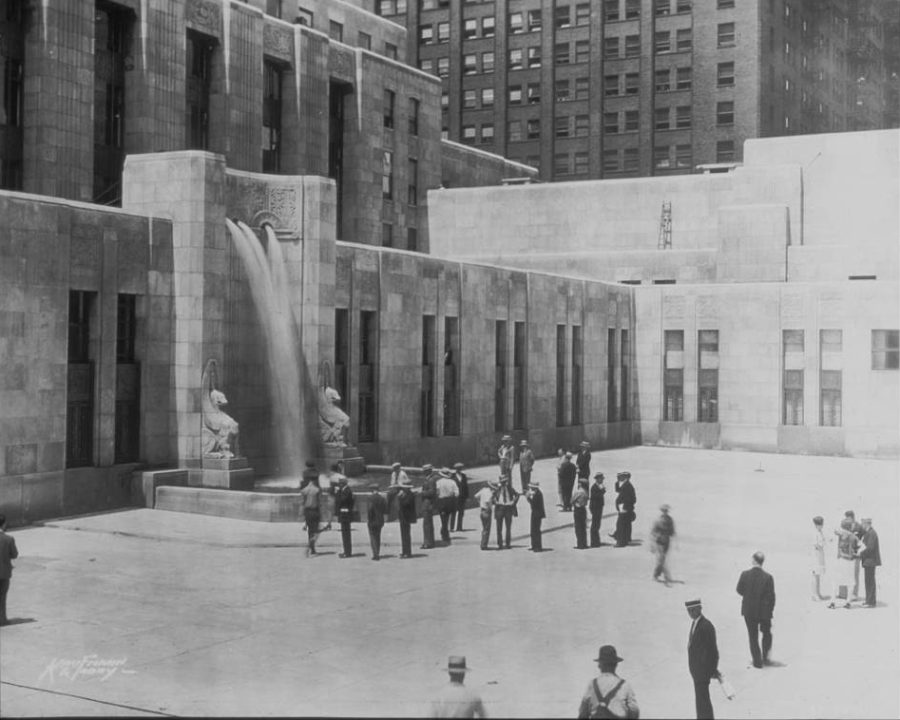
Daily News Plaza, courtesy of The Art Institute of Chicago
Embracing The River with a Grand Plaza
While Mies’ 1958 Seagram Building in New York is often credited with starting the trend of open air plazas, the Daily News building had it nearly 30 years earlier.
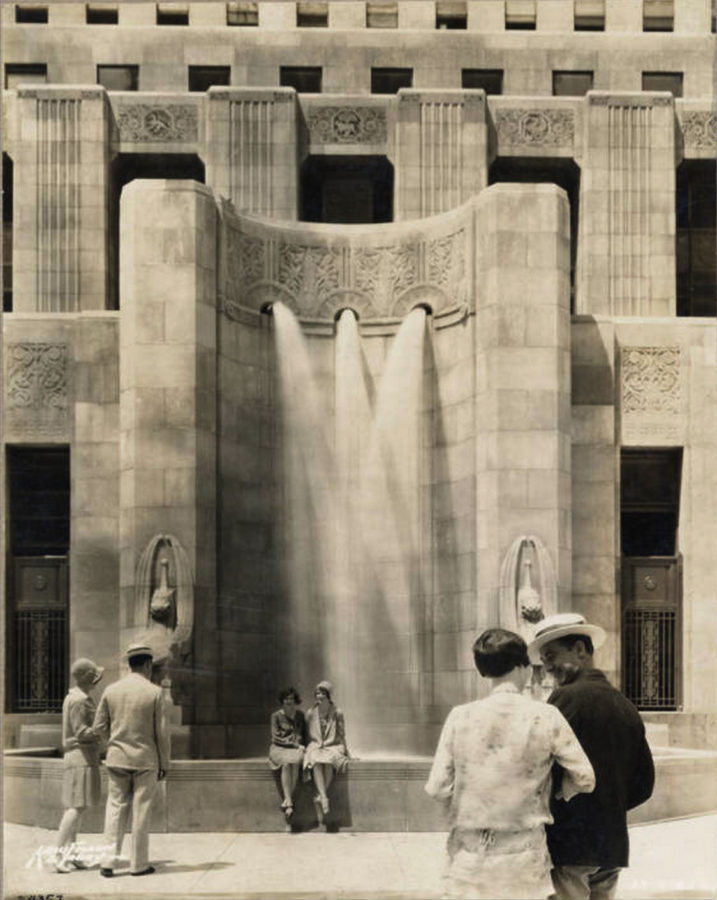
Daily News Building Plaza, courtesy of The Art Institute of Chicago
According to American Art Deco: Architecture and Regionalism, it was the first American skyscraper with an open air plaza as part of the design and, even more unusual in its orientation–facing the river.
All other buildings faced the opposite direction. The river was heavily polluted and not commonly viewed as an asset or object of beauty as it is today.
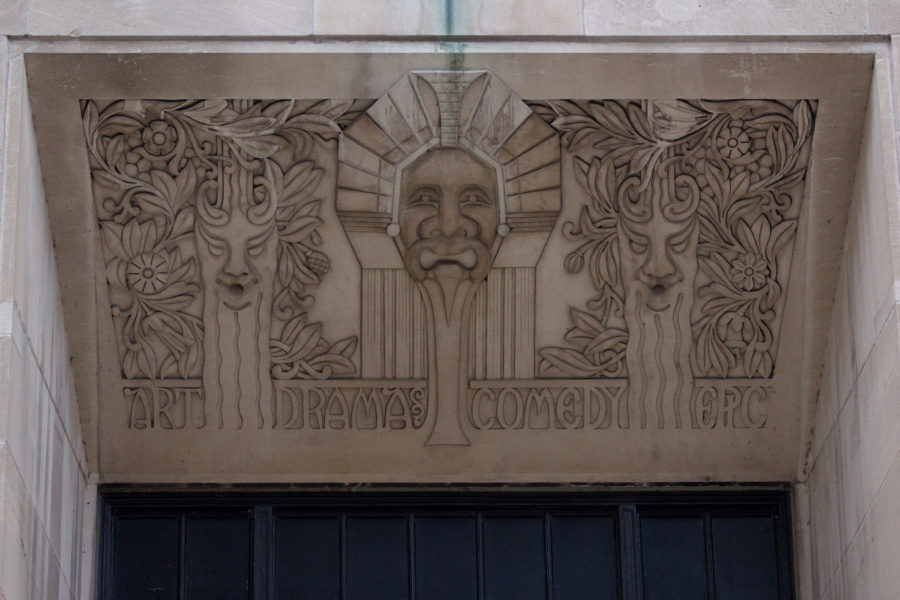
John Morris/Chicago Patterns
Lintels Heavier than a Truck
The building is adorned with multiple bas-relief panels depicting the history and culture of the written word. The largest ones are above the north and south entrances, weighing 12 tons each.

John Morris/Chicago Patterns
Pioneers of Print
There are eight important figures in newspaper and journalism history depicted on the fourth floor of the edifice, including:
- Ben Franklin
- Charles Anderson Dana
- Horace Greeley
- Joseph Pulitzer
- Samuel Bowles III/Samuel Bowles IV
- James Gordon Bennett, Sr./James Gordon Bennett Jr.
- Joseph Medill
- Victor Lawson

John Morris/Chicago Patterns
Milestone Markers
Notable figures in journalism are lionized in limestone as are events. The example above marks the first printing press.
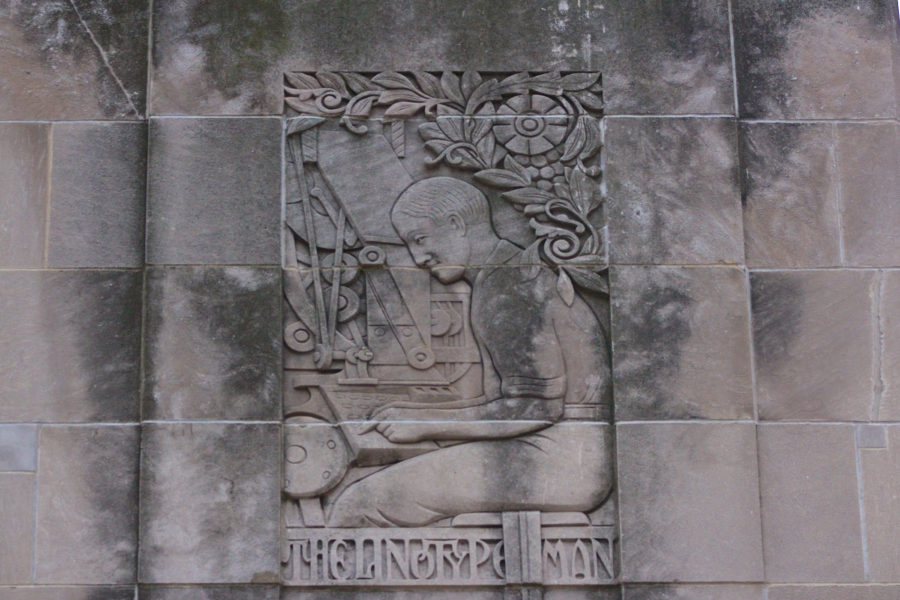
John Morris/Chicago Patterns
Line O’ Type
The celebration of the written word also recognized the common man, seen in the linotype man above.
The word linotype arose from its purpose: a device that could produce an entire line of type at once (a line of type – line o’ type).
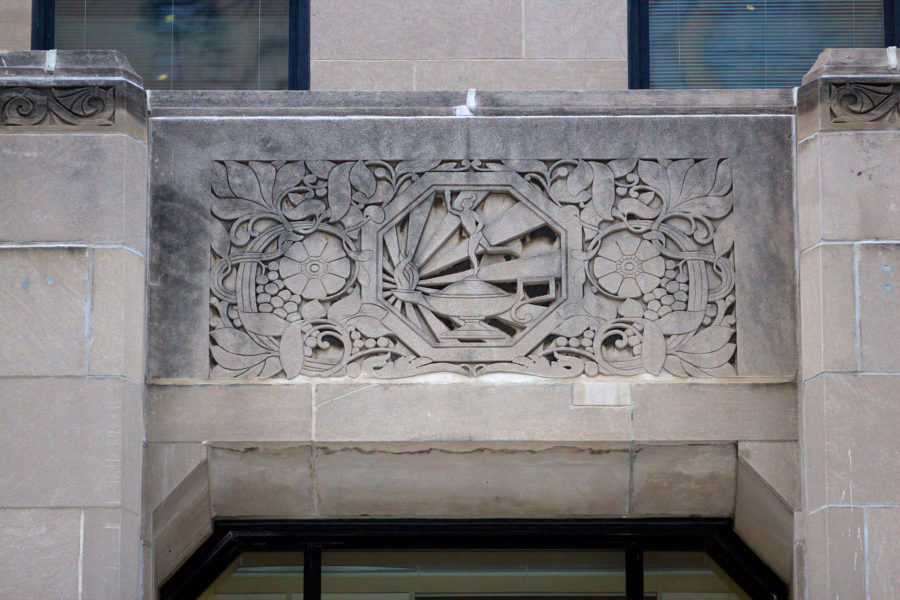
John Morris/Chicago Patterns
Anti-forgery Watermarks as Structural Ornament
Other ornament on the grand building is in the form of printers marks.
A Printer’s Mark is a device dating to at least the 1600s. It is like a trademark or logo, serving as proof that the book was created by a particular craftsman.
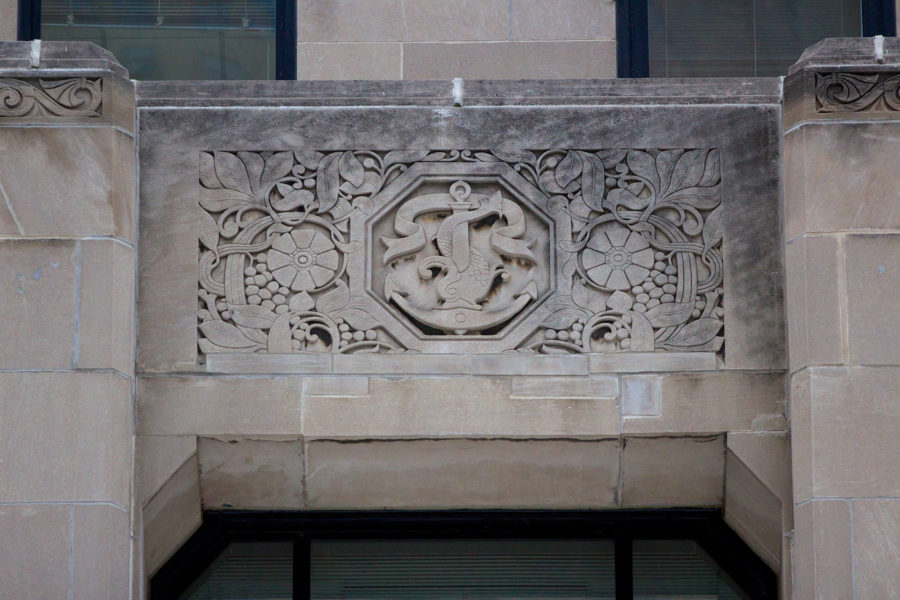
John Morris/Chicago Patterns
Similar to additions on photographs or more modern copy protection on software, the purpose was to prevent unauthorized duplication of created works.
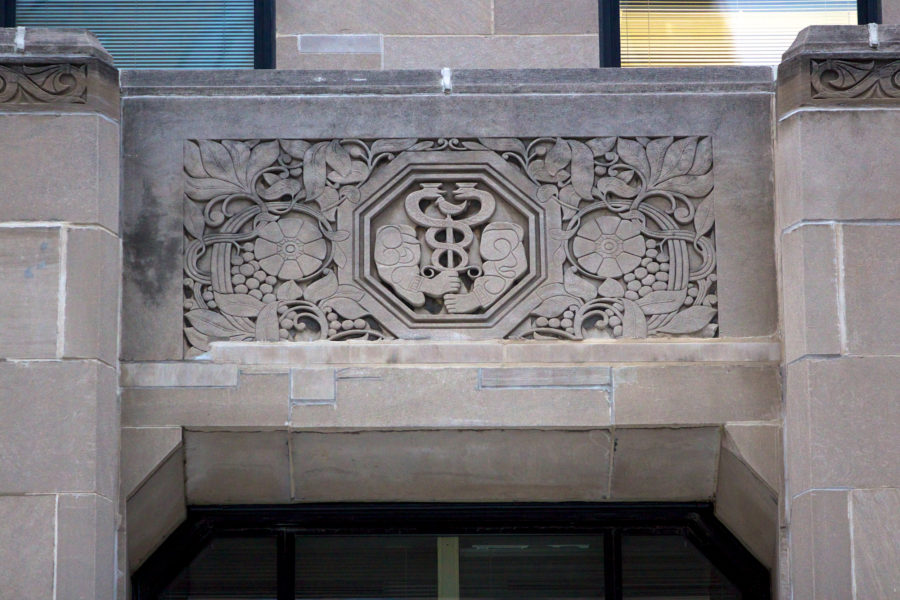
John Morris/Chicago Patterns
Over time they came to symbolize the printing house associated with the work. The Daily News Building celebrates the private enterprises that brought knowledge, entertainment, and literature to the masses.
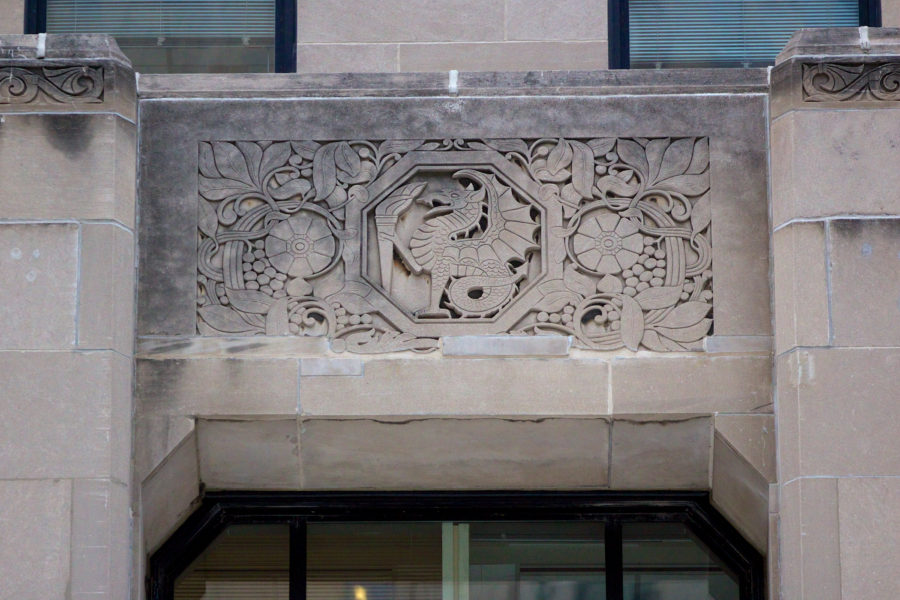
John Morris/Chicago Patterns
These printer’s marks are visible from the plaza.
Alvin Meyer sculpted these works as well as many others adorning buildings by Holabird & Root.
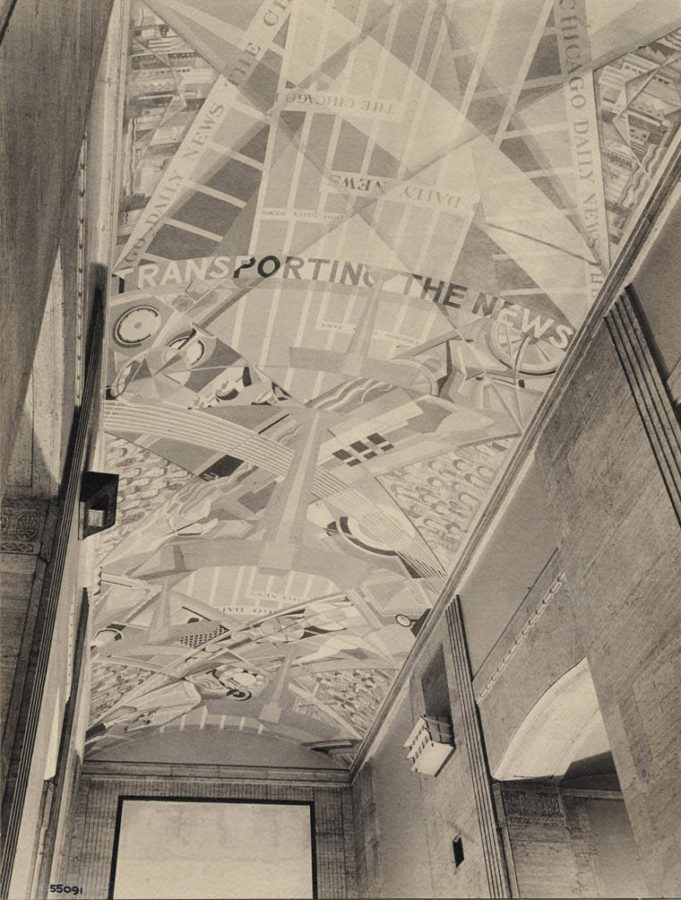
Courtesy of The Art Institute of Chicago
Treasure Inside: Gathering the News, Printing the News, Transporting the News
The bas-relief panels adorn this grand limestone structure like jewels on a treasure chest. Its treasure (currently removed) is an Art Deco mural by John W. Norton.
The mural depicts elements of journalism served up in a grand way to all entering the building. Like the exterior, it is in a modernistic style, featuring sharp lines and striking geometric shapes.
Journalist Marguerite Williams described the mural in this way:
A new kind of mural painting, born of the symbols of modern life and the magnitude of modern building….There, on the ceiling of a thoroughfare 180 feet long, will be read the romance of the modern newspaper ingeniously told by multifarious shapes and symbols–animate and mechanistic.
[…] a rhythmic teamwork of man and machine that makes the modern newspaper possible” and the “paraphernalia of news-gathering that has shrunk the globe into one neighborhood.
–Marguerite Williams
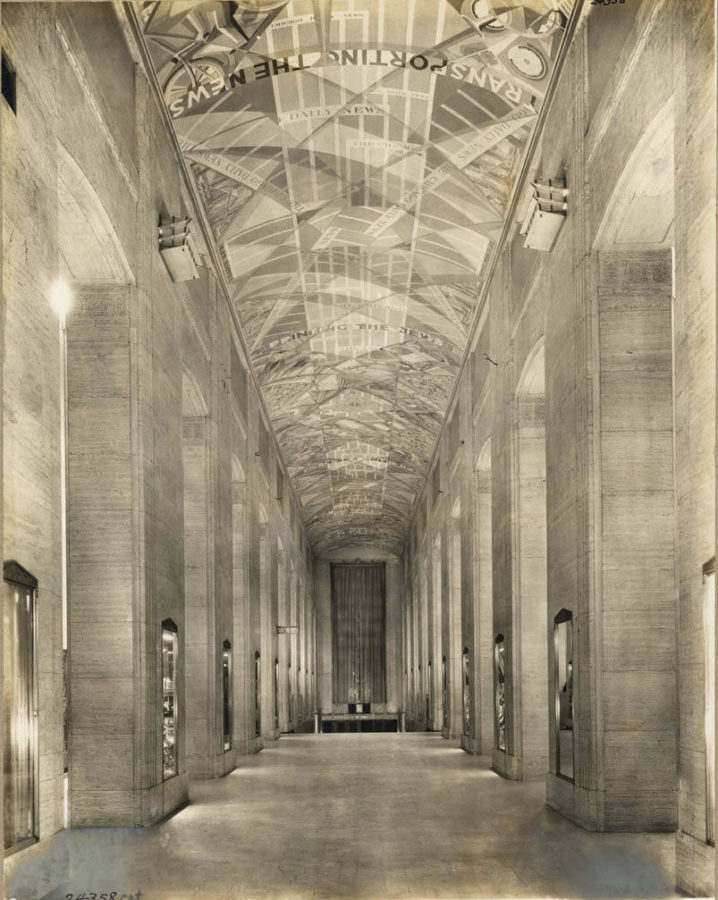
Courtesy of The Art Institute of Chicago
Removal of its Main Treasure
But sadly, this treasure is not viewable to the public. In 1993, the building’s owner, financier Sam Zell, removed the mural and announced plans to restore it. Restoration never happened, and it was speculated that the cost to restore it was more than he wanted to pay.
The best coverage of this sad chain of events over the years came from Blair Kamin of the Tribune. I recommend reading his 2004 article, News mural held hostage by dueling interests.
It is currently sitting in a warehouse, with little hope for a return to public view.
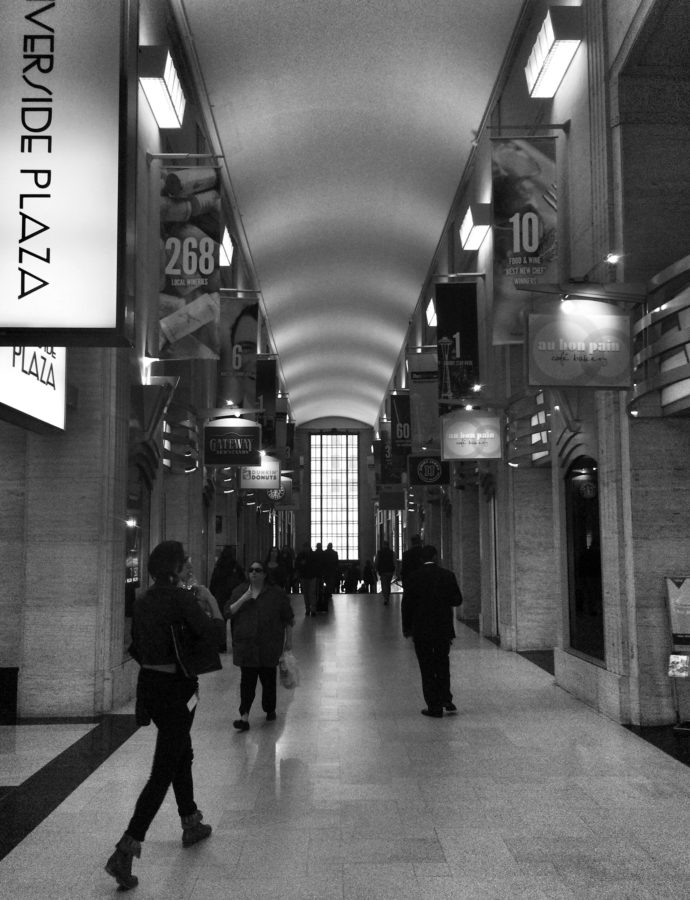
John Morris/Chicago Patterns
The Concourse Today, Minus the Mural
The main floor is full of activity during rush hour and lunch time as well as the plaza during the warmer days. A recent renovation added design elements that resemble Art Deco, but it doesn’t compare to its original design.
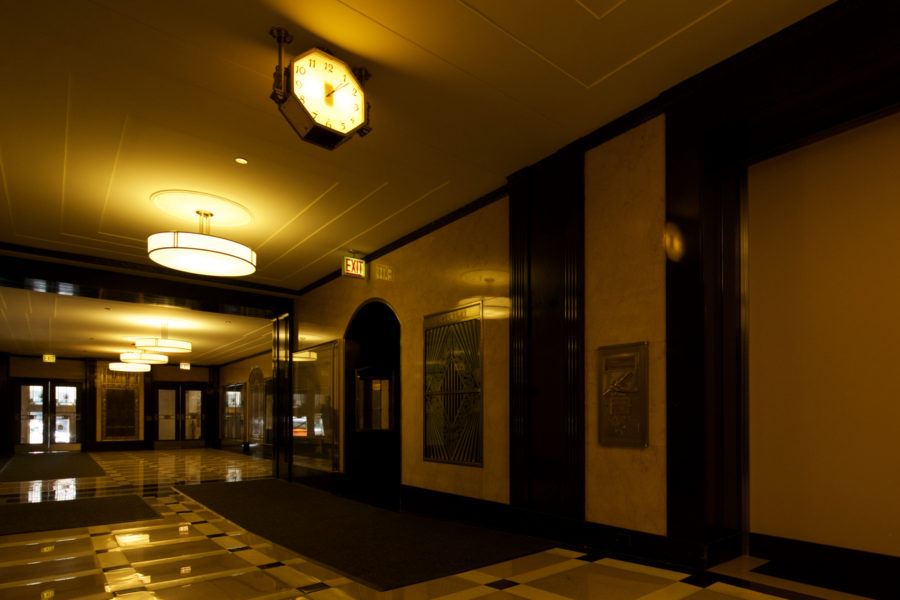
John Morris/Chicago Patterns
Though the main concourse features reproductions of Art Deco ornament, other sections of the building (Madison Street entrance above) are full of refined character.
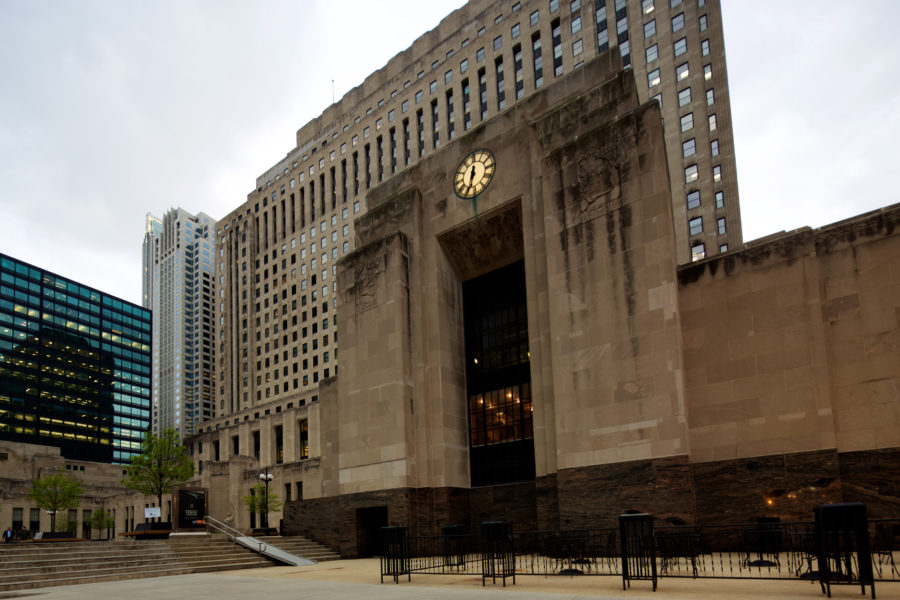
John Morris/Chicago Patterns
Saved From Demolition by Mayor Daley
As important as this building is architecturally and culturally to Chicago, it once faced demolition or severe alteration on more than one occasion.
One case occurred in 2000, as the Tribune’s Blair Kamin notes:
But now the old Chicago Daily News Building, one of Chicago’s finest examples of Art Deco architecture and a path-breaking work of engineering and urban design, has a sword dangling over its head.
The sword has been put there by its owner, billionaire financier Sam Zell, who has his offices in the 26-story building and is said to be weighing various options for the structure, which sits just east of the former Chicago & North Western railway station.
The owner was weighing options, which included a conversion to condos, a new office building on the plaza, or a complete demolition and replacement with a new building. Fortunately, Mayor Daley stepped in and made it clear that the building and plaza should be preserved as originally planned.
There was another scare in 2008 as Zell again announced plans for the site–a new office building on the plaza space. The economy prevented that potentially destructive action, but the plaza’s future is far from guaranteed.
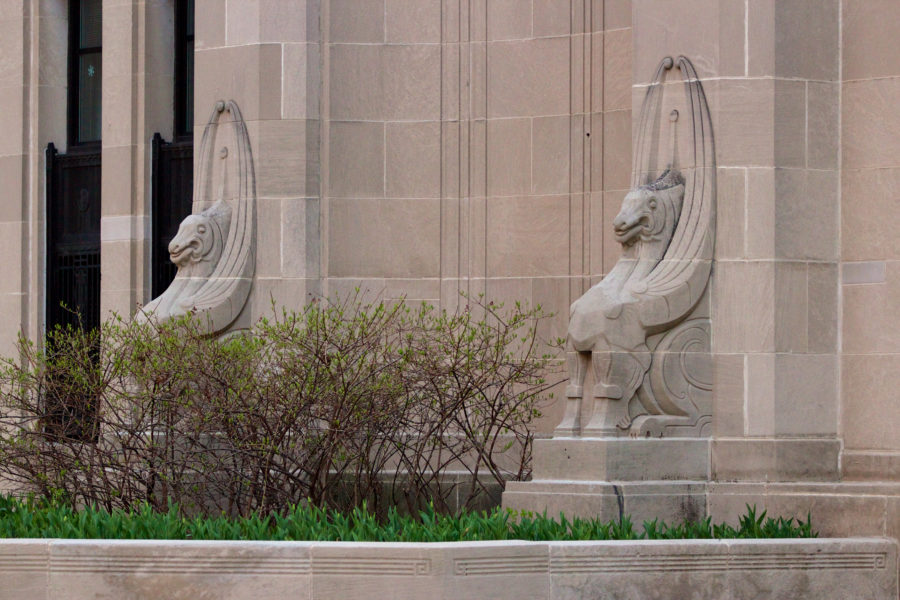
John Morris/Chicago Patterns
Though the fountain no longer functions and is frequently covered with advertisements, it remains intact today.
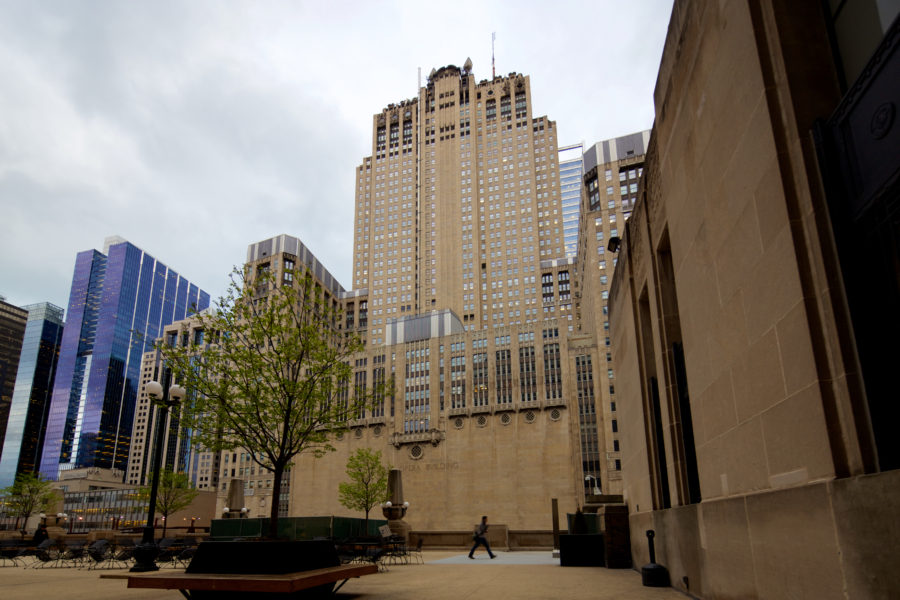
John Morris/Chicago Patterns
One of most striking features of the plaza is its view. The Civic Opera Building, designed in the same style, is directly across the river.
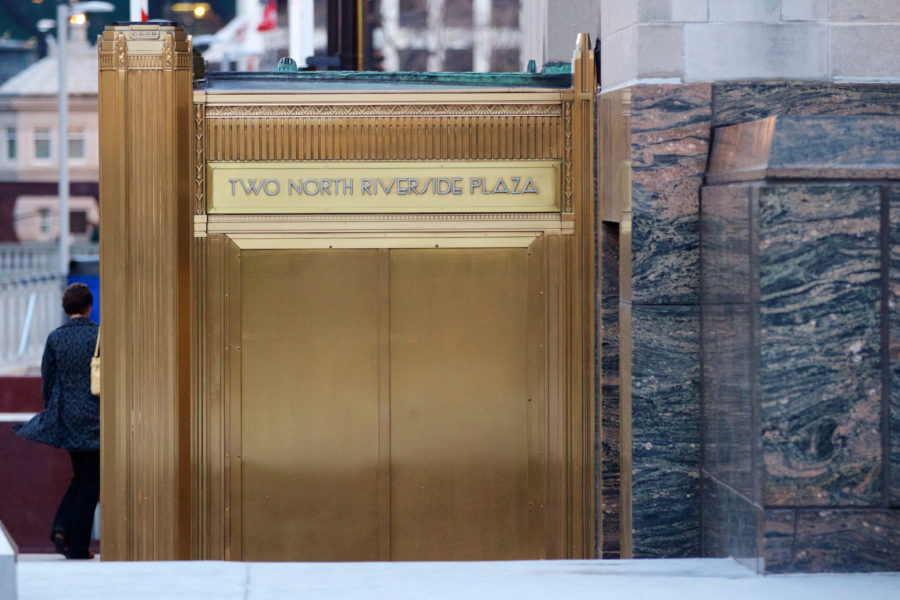
John Morris/Chicago Patterns
The Daily News Building (now Two Riverside Plaza) serves as a connector to Ogilvie Transportation Center.
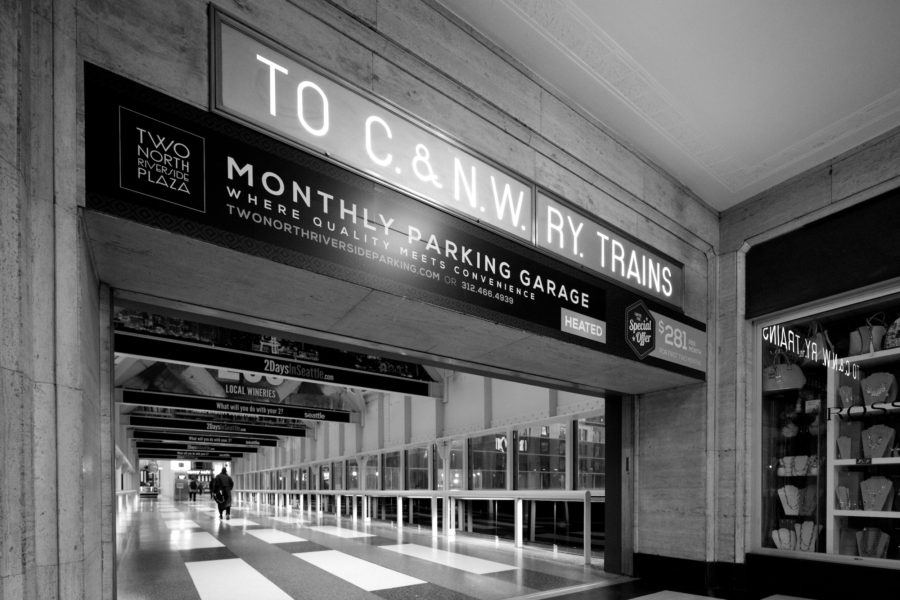
John Morris/Chicago Patterns
The concourse that connects to Ogilvie via a pedestrian bridge (above), originally the main lobby.
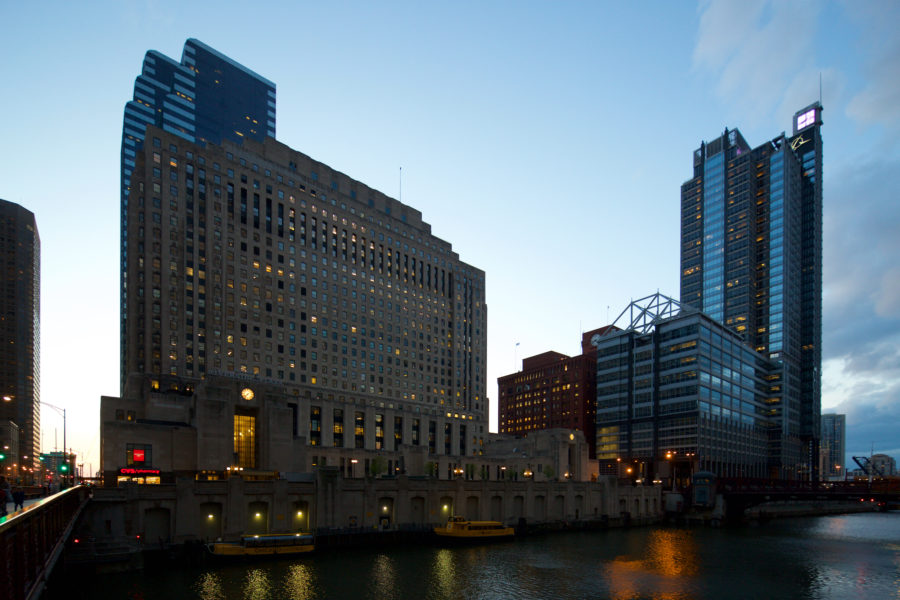
John Morris/Chicago Patterns
The Daily News Building is one of the most important pieces of architecture in Chicago. Though the interior mural is hidden away in storage, there are plenty of interior hidden works of art with dazzling geometry and color.
References and Further Reading
- Chicago Daily News Inc. (Encyclopedia of Chicago)
- Daily News Building archival collection (The Art Institute of Chicago)
- News mural held hostage by dueling interests (Chicago Tribune)
- How to protect the Daily News Building (Chicago Tribune)
- Daley To Zell: Don’t Alter The Daily News Building And Its Riverfront Space (Chicago Tribune)
- Redesign of Chicago Daily News Building Under Way (National Trust for Historic Preservation)
Related Art Deco Articles
- Patroness of the Road that Never Was: Loyola’s Madonna della Strada Chapel
- Chicago Bee: Cornerstone of the Black Metropolis
- The Legacy of Schulze Baking Company, Part 1


Was there a bad fire on the Washington Street side of the building at one time?